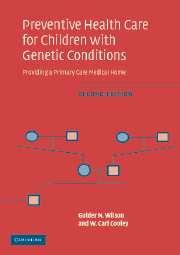Book contents
- Frontmatter
- Contents
- Preface
- Glossary of genetic and molecular terms
- Part I Approach to the child with special needs
- Part II The management of selected single congenital anomalies and associations
- Part III Chromosomal syndromes
- 7 Autosomal aneuploidy syndromes
- 8 Sex chromosome aneuploidy and X-linked mental retardation syndromes
- 9 Chromosome microdeletion syndromes
- Part IV Syndromes remarkable for altered growth
- Part V Management of craniofacial syndromes
- Part VI Management of connective tissue and integumentary syndromes
- Part VII The management of neurologic and neurodegenerative syndromes
- Part VIII Management of neurodegenerative metabolic disorders
- References
- Index
7 - Autosomal aneuploidy syndromes
Published online by Cambridge University Press: 29 January 2010
- Frontmatter
- Contents
- Preface
- Glossary of genetic and molecular terms
- Part I Approach to the child with special needs
- Part II The management of selected single congenital anomalies and associations
- Part III Chromosomal syndromes
- 7 Autosomal aneuploidy syndromes
- 8 Sex chromosome aneuploidy and X-linked mental retardation syndromes
- 9 Chromosome microdeletion syndromes
- Part IV Syndromes remarkable for altered growth
- Part V Management of craniofacial syndromes
- Part VI Management of connective tissue and integumentary syndromes
- Part VII The management of neurologic and neurodegenerative syndromes
- Part VIII Management of neurodegenerative metabolic disorders
- References
- Index
Summary
Embryonic or fetal death is most likely when chromosomes 1–22 (autosomes) are deficient or duplicated (chromosomal aneuploidy). Fetuses that do survive to be born will usually have multiple medical problems, including growth failure, developmental delay, predisposition to infection, and multiple major or minor anomalies. Sex chromosome aneuploidies (e.g., Turner or Klinefelter syndromes) are discussed in a separate chapter (see Chapter 8) since their milder mental disability, specific behavioral issues, and fewer congenital anomalies are different from the autosomal aneuploidies. The new category of microdeletions revealed by fluorescent in situ hybridization (FISH) techniques (e.g., Prader–Willi, Smith–Magenis syndromes) are discussed in Chapter 9.
There are three major categories of chromosome aneuploidy – extra or missing whole chromosomes (trisomy, monosomy), extra or missing parts of a chromosome (partial trisomies or duplications, partial monosomies or deletions), and mixtures of normal and aneuploid cells (mosaicism). Few complete trisomies (except for 8, 9, 13, 18, and 21) and probably no complete monosomies (with possible exceptions for 21 and 22) survive the prenatal period to be born. The majority of live births with trisomies other than 13/18/21 are mosaic, and it is not surprising that prenatal diagnostic studies reveal a significant frequency of mosaicism.
The key to management for individually rare but categorically significant autosomal disorders is to merge common complications shared by these disorders, as outlined in Table 7.1,with risks unique to the particular chromosome aberration (Tables 7.2 and 7.3).
- Type
- Chapter
- Information
- Preventive Health Care for Children with Genetic ConditionsProviding a Primary Care Medical Home, pp. 151 - 193Publisher: Cambridge University PressPrint publication year: 2006



